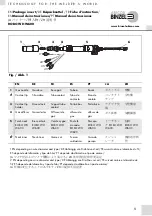
21
the wort. Leave the wort to ferment at the desired temperature.
You can read more about the bottling and kegging process later
in this user manual.
Note: Although debated, getting trub into your fermenting
vessel will normally not cause any unfavourable flavor or aroma
to your finished beer. Trub will sink to the bottom together
with most of the yeast after the fermentation has finished.
Tip: Add some water to the air-lock before using.
You have now finished brewing and it is time to empty and clean
all the equipment. Follow the procedure for this described later
in this user manual.
6.3 - HOW TO DO MULTI STEP MASHING
The Beer Brew Automatic™ brew controller is designed with
simplicity in mind, and for supporting single step mashing.
Single step mashing is used in most recipes and for the most
types of malt. Today, the malting process will produce the
required enzymes in the malt that will convert the starches to
fermentable sugar during a single step mashing.
But, multi step mashing is preferred by some brewers. Step
mashing is also required for some types of malt, for example
unmalted wheat. Multi step mashing is mashing at different
temperature stages, starting with a low temperature, the
increase and hold the temperature for some time for each step
before continuing.
Examples of multi step mashing steps with their formal name
and description:
• Phytase (30-53°C) – Lowers the pH of the mash slightly.
Lowering the mash pH has a number of benefits, though
a Phytase is rarely used by modern brewers, as there are
alternate ways to control mash pH.
• Debranching (35-44°C) – Helps to increase the solubility
of starches resulting in increased extraction for certain
malts.
• Beta Glucanese (35-45°C) – Breaks down the gummy
heavy starches which can help improve stability and
extraction, particularly for mashes high in proteins and
adjuncts such as wheat.
• Peptidase (45-53°C) – Produces free amino nitrogen
which can aid in fermentation.
• Proteinase (50-59°C) – breaks down long chain proteins
to shorter proteins. Beneficial for the body and foam
retention in the beer. Reduced haze.
• Beta-amylase (55-66°C) – starch conversion producing
maltose, which ferments well and produces a dyer beer with
a thinner body.
• Alpha-amylase (66-71°C) – starch conversion producing
less fermentable sugar causing the beer to be more full-
bodied and with a malt sweetness.
A typical multi-step mashing for a pilsner style beer could be:
• 45°C for 15 minutes
• 60°C for 15 minutes
• 66°C for 30 minutes
followed by a 75°C, 5 minutes of mashout, however, the mashout
is here included as part of the lautering phase when using the brew
controller as described earlier in this user manual.
The mashing described here will take about 90 minutes if we
estimate a 15 minutes temperature rise time between each step.
To use the brew controller to support this multi-step mashing
you need to perform the following:
• Set up the equipment according to description earlier in
this user manual.
• Add the water for mashing.
• Calculate your target strike water temperature. In this
example 48°C is used.
• Switch on the brew controller
• Adjust the target strike temperature to 49°C.
• Adjust the mash time to 90 minutes, i.e.the total mash
time, including the estimated temperature rise time
between each step.
• When target strike temperature is reached, adjust the mash
temperature to 45°C.
• Mash in and put the lid on, connect the lid hose CamLock
connector to the riser pipe. Turn the riser pipe valve halfway
open and start the pump to circulate the water over the top
of the mash.
• After 15 minutes mash time (75 minutes remaining), adjust
the mash temperature to 60°C. Wait until the temperature
in the mash reach 60°C.
• After another 15 minutes mash time (55 minutes
remaining), adjust the mash temperature to 66°C. Wait
until the temperature in the mash reach 66°C.
• After 30 minutes of the remaining mashing time, the mash
phase should be over, and the next phase, with mashout will
start.
Note: you may need to, and can, extend or shorten the mash
time any time during the mashing phase depending on how
long time it takes to mash in, and to rise the temperature
between each step.
Sources:
http://howtobrew.com/book/section-3/how-the-mash-works/
Beersmith.com blog 2013/08/02 “Multi vs Singel Step mashing
for home brewing”
BYO.com article 2008 Jan/Feb: “The science of Step mashing”








































